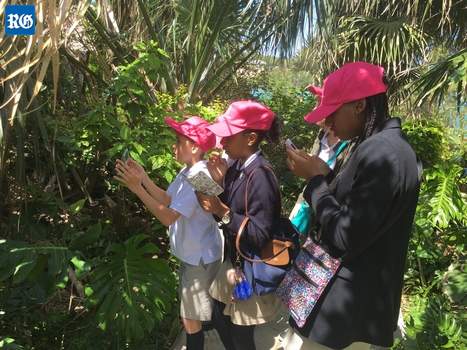Recent News
Colourful Madagascar reptiles hatch in BermudaThursday, May 22, 2014
Two newly-born colourful lizards that are a threatened species due to the reptile trade are settling into their new home at the Bermuda Aquarium, Museum and Zoo (BAMZ).
Bermudian to play a role in ocean plastics research mission
Monday, May 19, 2014
Marine research crews aboard the Sea Dragon, a 72ft expedition ship, departed Bermuda on Saturday for an eight-day voyage into the Sargasso Sea hoping to learn more about how plastics are distributed throughout ocean depths.
No evidence pesticides are killing Island’s toads
Wednesday, May 14, 2014
Vehicle emissions and other pollutants are partly to blame for falling amphibian numbers in Bermuda, according to an expert.
Reefs in fairly good condition, but report highlights some concerns
Monday, May 12, 2014
Bermuda Zoological Society (BZS) has officially presented its 2013 Reef Watch report to Government, containing data recently gathered on the health of the Island’s reefs.
BZS Reef Watch Report Presented To Ministers
Thursday, May 08, 2014
The Bermuda Zoological Society has officially presented the 2013 Reef Watch Report to Trevor Moniz, Minister for Health & Environment and Patricia Gordon-Pamplin, Minister of Public Works.
About
GovernanceAbout Us
Newsletter
Latest News
Gift & Bookstore
Contact
General Inquiries
info@bzs.bm
Latest News
All the latest updates and news from the Bermuda Aquarium, Museum, and Zoo, one of Bermuda's leading visitor attractions!
Cindy Corday
Published May 25, 2017 at 8:00 am (Updated May 24, 2017 at 11:15 pm)

Springboard for learning: students explore the fascinating world of BAMZ
Bermuda Centre for Creative Learning teachers were recently contemplating how to inspire their students to create a non-fiction children’s information book.
Rather than take the traditional route: providing them with a list of subjects, or a supply of books to look through, they thought — why not use the Bermuda Aquarium Museum and Zoo, BAMZ, as a springboard for student learning, and let them lead the way? Students in this multi-age setting, began this non-fiction genre with a discussion about their prior experiences at BAMZ; the areas they recalled visiting and the animals and exhibits they enjoyed the most.
With BAMZ site maps, students were divided into small skill-set groups and created a plan of action for their upcoming trip to the site, based solely on their interests. A few days later, with digital devices in hand, they set off to BAMZ, super excited about their role as junior photographers.
Apart from a few guidelines from their teachers: take images of the animals and the signage at exhibits, stay with your group and be polite to others around you, the students cruised confidently throughout the site with great enthusiasm.
The interesting thing about this trip was that very little planning was involved — yet this experience took on a life of its own. Students worked really well with and helped each other. One commented, “Hey, here’s the Fossa, this is the animal I was telling you about! We’ve got to get a picture of him!” and another, “I was right, the flamingos get their colour from what they eat!” After the trip, and with parent help, students came back to school with the images they took loaded on to flash drives. The range of help from that point was differentiated: younger primary students had help printing their images and hand writing information, while older students set up PowerPoint pages, inserted the images and typed information about each animal in text boxes. Features of non-fiction text then became a meaningful process, because it was inspired by their work.
The end results proved that students who are involved in the process of their own learning, are far more engaged in the activity, retain information easily, than gathering information solely from a textbook or the internet. While helping to bind his book, one student noticed an error in the text and commented, “Wait, I see a problem on the page about the alligator. It says that most alligators eat about 50 meals a year, and the number of meals that humans eat isn’t there, it should say 1,000.” It was apparent that this student felt empowered about his project, clearly what teachers were hoping for.
Another aspect of learning at BCCL is to have empathy for others. Students wore pink baseball caps during the trip in honour of Mrs Kitty Ray, a friend who lives in Alexandria, Virginia and is courageously battling cancer. The Bermuda Centre for Creative Learning is a private school for students who have Dyslexia and other language-based learning differences beginning from age seven. BCCL is the first school of its kind on island, with the goal of changing the conversation about individuals who learn differently.
•Visit www.bermudacreativelearning.com for information


